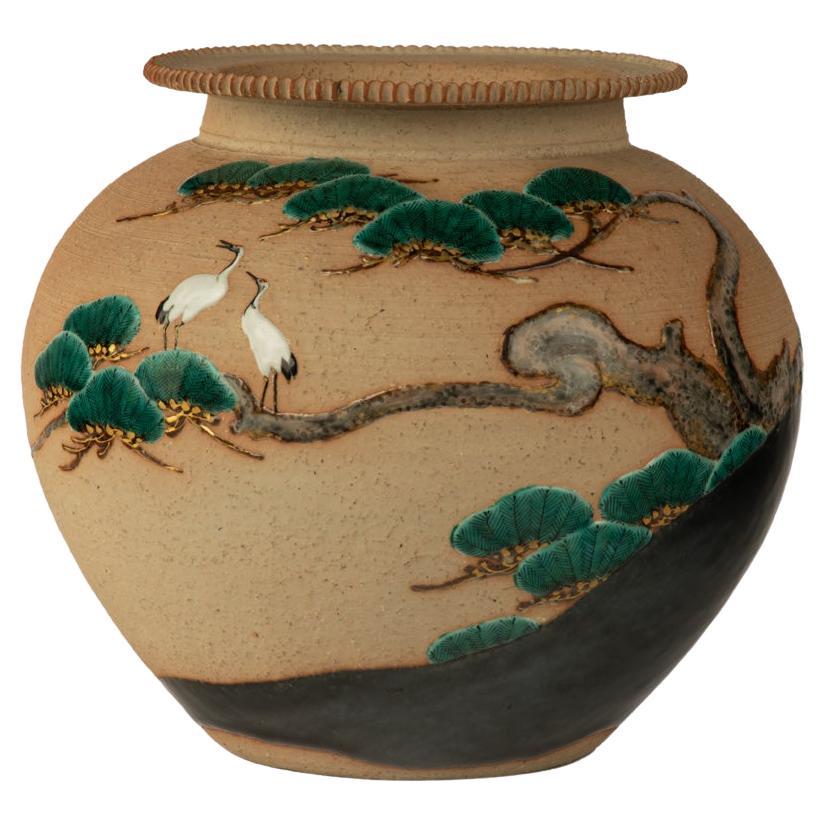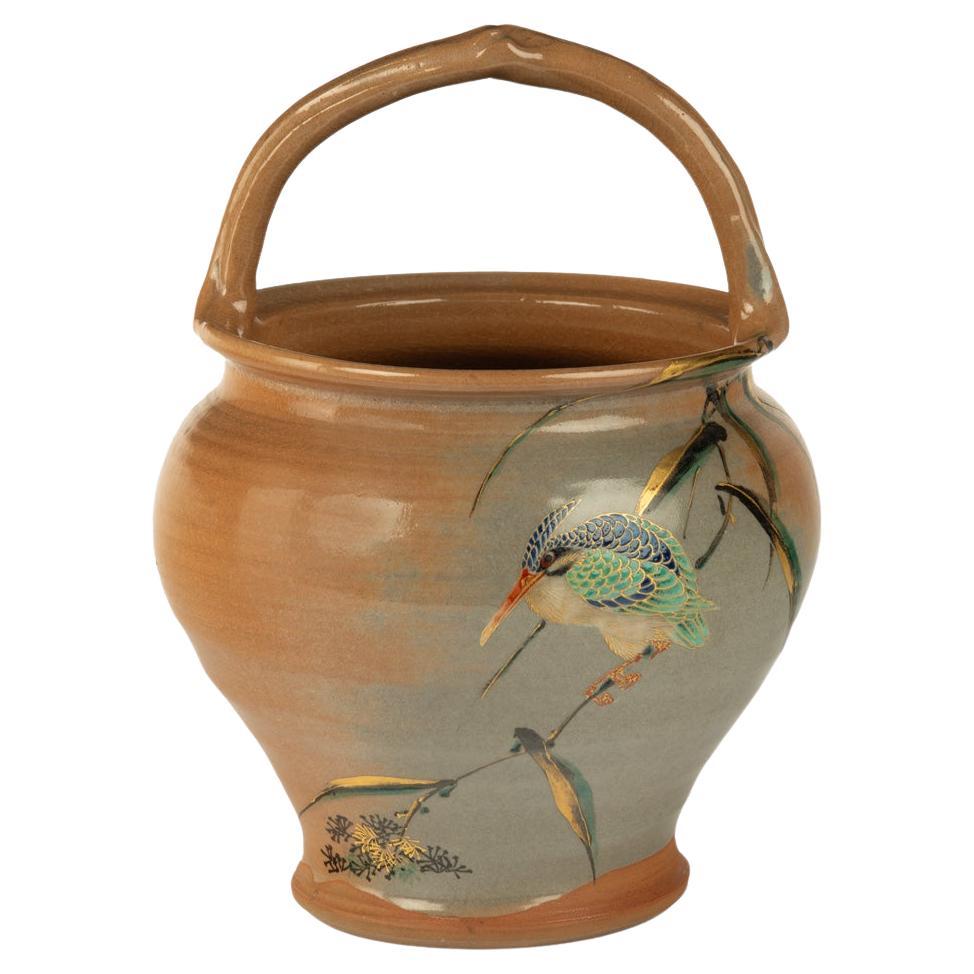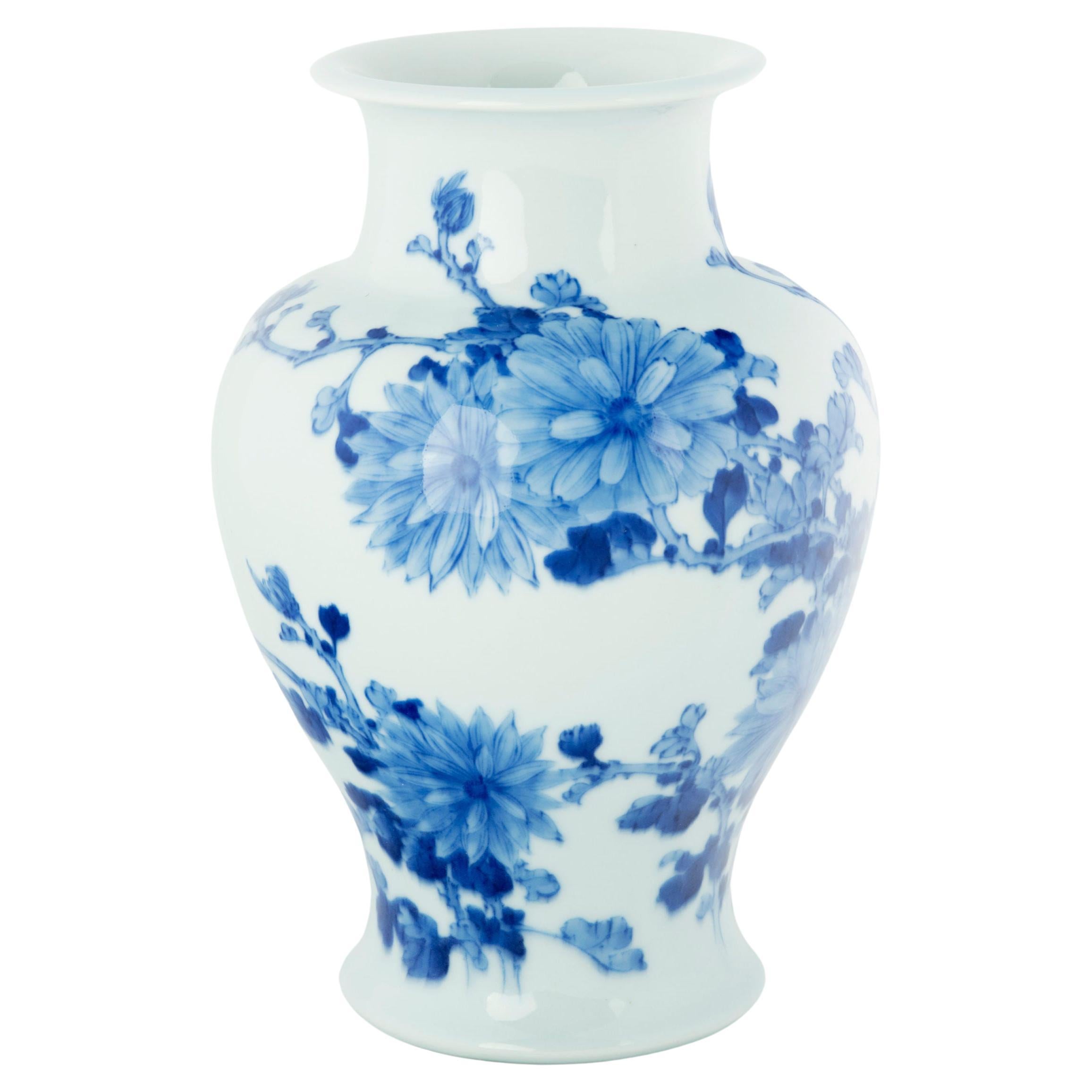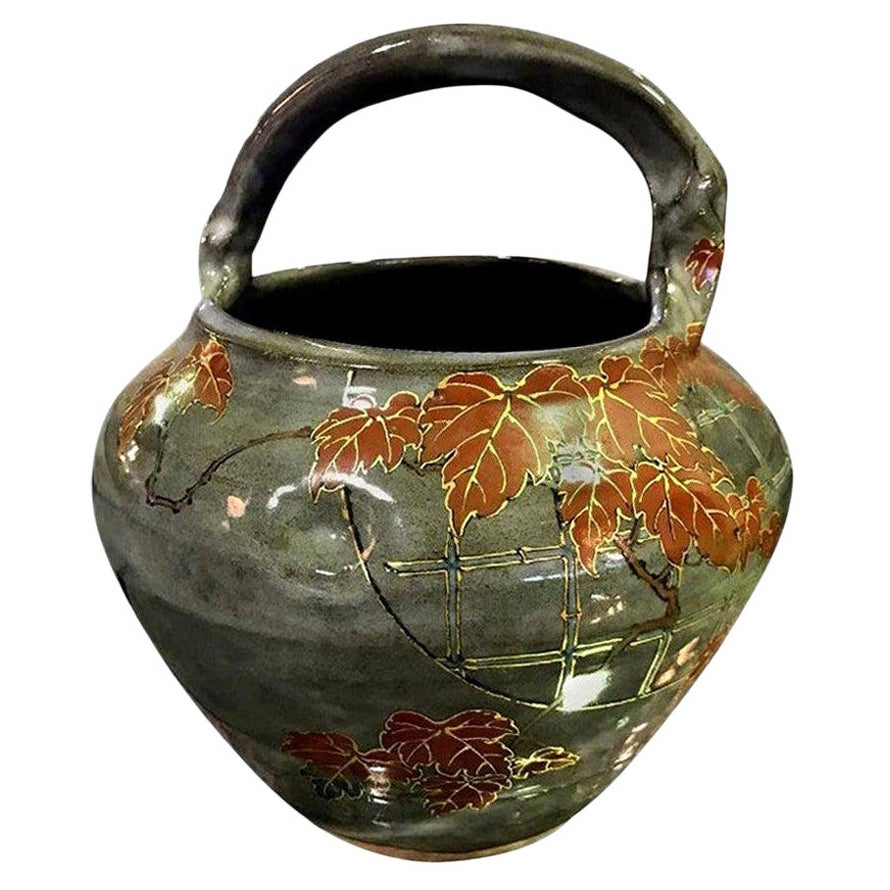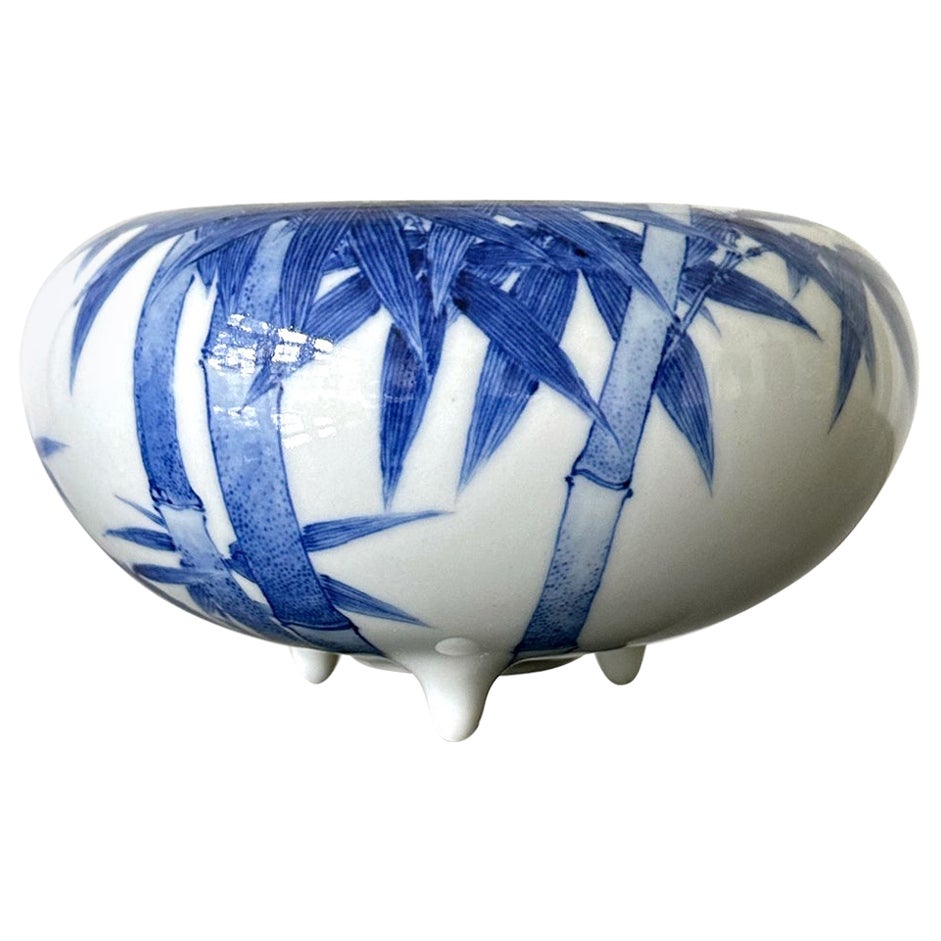Items Similar to Charming Japanese Okimono Mandarin Ducks - Makuzu Kozan II
Want more images or videos?
Request additional images or videos from the seller
1 of 8
Charming Japanese Okimono Mandarin Ducks - Makuzu Kozan II
About the Item
As part of our Japanese works of art collection we are delighted to offer this most charming late Meiji (1868-1912) Taisho period (1912-1926) , ceramic study of Mandarin ducks from the studio of the highly regarded imperial artist Miyagawa Makuzu Kozan (1842-1916) on this occasion likely to be Kozan II (1859-1940).The highly skilled artist has crafted a captivating study of a pair of Mandarin ducks with the male presiding over the female who is resting upon a rocky outcrop. The birds incredibly well painted in vibrant colours in such a lifelike detail then highly fired in the kiln, the underside stamped with the oval Kozan seal. A rare and most enchanting okimono from one of the leading Imperial studios of the period, these birds would grace any serious Japanese ceramics collection.
Literature :
The oval impressed seal is referenced in the index of signatures page 237 in the Sir Nasser D Khalili Collections Ceramics I, as being used after 1910 and into the 1920's period.
Provenance :
Private USA Collection.
Condition report :
Fine condition throughout.
Approximate Sizes :
Length : 6 7/8" 17 cm
Depth : 4 1/4" 11 cm
Height : 4 3/4" 12 cm
Free worldwide delivery and a certificate of authenticity are included within the price of this item. EP84
- Creator:Makuzu Kozan II (Artist)
- Dimensions:Height: 4.75 in (12.07 cm)Width: 6.88 in (17.48 cm)Depth: 4.25 in (10.8 cm)
- Style:Taisho (Of the Period)
- Materials and Techniques:
- Place of Origin:
- Period:
- Date of Manufacture:1920
- Condition:Wear consistent with age and use.
- Seller Location:Christchurch, GB
- Reference Number:1stDibs: LU8622237751542
About the Seller
5.0
Vetted Seller
These experienced sellers undergo a comprehensive evaluation by our team of in-house experts.
Established in 2011
1stDibs seller since 2023
Typical response time: 1 hour
- ShippingRetrieving quote...Ships From: Christchurch, United Kingdom
- Return PolicyA return for this item may be initiated within 14 days of delivery.
More From This SellerView All
- Captivating Japanese Stoneware Jardiniere by Makuzu Kozan IIBy Makuzu Kozan IILocated in Christchurch, GBAs part of our Japanese works of art collection we are delighted to offer this most captivating Late Meiji (1868-1912) early Taisho period (1912-1926 ),globular stoneware vessel stem...Category
Vintage 1920s Japanese Taisho Ceramics
MaterialsStoneware
- Unusual Japanese Studio Vase by Makuzu Kozan IIBy Makuzu Kozan IILocated in Christchurch, GBAs part of our Japanese works of art collection we are delighted to offer this most unusual Late Meiji (1868-1912) early Taisho period (1912-1926 ), globular vase stemming from the h...Category
Vintage 1920s Japanese Taisho Ceramics
MaterialsEarthenware
- Japanese Ceramic Vase by Makuzu KozanBy Makuzu Kozan IILocated in Christchurch, GBAs part of our Japanese works of art collection we are delighted to offer this charming Meiji Period 1868-1912, ceramic baluster vase from the studios of the highly coveted Imperial ...Category
Antique 19th Century Japanese Meiji Ceramics
MaterialsCeramic
- Large Japanese Ceramic Vase by Makuzu KozanLocated in Christchurch, GBAs part of our Japanese works of art collection we are delighted to offer this tapering square form Meiji Period 1868-1912, ceramic vase from the studios of the highly coveted Imperi...Category
Antique 19th Century Japanese Ceramics
MaterialsCeramic
- Charming Japanese Bronze Turtle Okimono by SeiminLocated in Christchurch, GBAs part of our Japanese works of art collection we are delighted to offer this charming Meiji Period 1868-1912, bronze okimono group of a cluster of turtles, possibly Japanese pond t...Category
Antique 19th Century Japanese Meiji Sculptures and Carvings
MaterialsBronze
- Large Japanese Satsuma Vase by KinkozanBy KinkozanLocated in Christchurch, GBAs part of our Japanese works of art collection we are delighted to offer this finely decorated Meiji Period (1868-1912), Satsuma vase stemming from the highly regarded Kinkozan stud...Category
Antique Late 19th Century Japanese Meiji Ceramics
MaterialsCeramic
You May Also Like
- Makuzu Kozan II Signed and Stamped Japanese Ceramic Flower Pottery Bowl Pot VaseBy Makuzu Kozan IILocated in Studio City, CAA beautiful handmade handled bowl by well-known Japanese ceramic artist Makuzu Kozan II, son of Makuzu Kozan who was appointed artist to the Japanese Imperial household and was one o...Category
Vintage 1930s Japanese Showa Ceramics
MaterialsCeramic
- Japanese Glazed Ceramic Bowl by Makuzu KozanBy Makuzu KozanLocated in Atlanta, GATri-pod ceramic bowl likely used as an incense burner (koro) by Japanese Imperial potter Makuzu Kozan (1842-1916) circa late Meiji period. The signature indicates that it was produce...Category
Antique 1880s Japanese Meiji Ceramics
MaterialsCeramic
- Japanese Ceramic Bowl Makuzu Kozan Utusushi KenzanBy Makuzu KozanLocated in Atlanta, GAA rare ceramic bowl with over glaze painted decoration by Japanese imperial potter Makuzu Kozan ((1842–1916). Unlike the better known works Kozan made for the expositions in the west and export to the foreign market, this piece exemplifies his work for the domestic market and the tea ceremony. The bowl was made in the so called "Utusushi" Ogata Kenzan (1663-1743), an celebrated Edo painter and ceramicist. Utusushi is loosely translated as "in the spirit of". It is not at all a simple imitation of a master, but a Japanese concept of embracing the spiritual essence of a master while the creator is free to mix in his or her own unique artistic interpretation and flavor. The bowl was made to hold fruits during the tea ceremony. It has a very distinguished form with a circular lower body morphing into a square upper portion that further opening with flared rim. The surface has a grey glaze onto which Asagao flowers (Japanese morning glory) on the vines were painted in a free and poetic style. White was used for the petals, green for the leaves with touches of gold highlight. Asagao, the symbol of the summer was rendered in the spirit of Ogata Kenzan, and interestingly the shape of the blossom echoes the unique form the bowl. It was likely reserved for the tea ceremony during the summer months. Under the base, Kozan was signed in black on an white porcelain plaque inlay. For two similar examples of Kozan's work Utusushi Kenzan, see Page 168-169 of the book: Sekai ni Aisa Reta ya Kimono Miyagawa Kozan Makuzu...Category
Antique Early 1900s Japanese Japonisme Ceramics
MaterialsCeramic
- Japanese Porcelain Vase Meiji Period Makuzu KozanBy Makuzu KozanLocated in Atlanta, GAA finely decorated and glazed Japanese porcelain vase by Makuzu Kozan (1842-1916) circa 1900s Meiji Period. The vase is of a classic bottle form with baluster body and short neck. It was decorated with underglaze white magnolia blossom on a pleasant celadon background. The stamens of the flower were artistically rendered in a low relief, giving the design a realistic appeal with the dimension. Miyagawa Kozan...Category
Early 20th Century Japanese Meiji Ceramics
MaterialsPorcelain
- Japanese Porcelain Vase Makuzu Kozan Meiji PeriodBy Makuzu KozanLocated in Atlanta, GAA striking blue and white vase from the studio of Japanese Potter Makuzu Kozan, also known as Miyagawa Kozan (1842–1916), one of the most established and collected ceramist from Meiji Period. Born as Miyagawa Toranosuke, Kozan established his pottery studio in Yokohama circa 1870s and later became one of the appointed artists to the Japanese Imperial household. His work was exhibited in many international fairs that the Meiji government participated at the turn of the century and won many grand prizes. Of a relatively large size, this vase is decorated with underglaze cobalt blue using the novel technique developed by Kozan called Fuki-e (the blow painting). As a result, the bamboos appear took on a three-dimensional quality as if appearing in a mist. Known as one of the most creative ceramists, circa 1887, Kozan started experimenting with new chemical colors from the West in the format of his porcelain glaze. New colors allowed him to create underglaze design that appeared bright, smooth and glossy. He even invented his own receipt of cobalt blue to achieve a much brighter yet softer shade, as evident on this vase. To create landscape that is realistic and dimensional, more common in the western paintings, he was inspired by the native Japanese ink painting technique developed around 1900 by Yokoyama Taikan...Category
Antique Early 1900s Japanese Japonisme Ceramics
MaterialsCeramic
- Rare Large Japanese Porcelain Presentation Plate Makuzu KozanBy Makuzu KozanLocated in Atlanta, GAA large presentation plate with striking pictorial design from the studio of Japanese Potter Makuzu Kozan. Also known as Miyagawa Kozan (1842–1916),...Category
Early 20th Century Japanese Meiji Ceramics
MaterialsPorcelain
Recently Viewed
View AllMore Ways To Browse
Red Blue Japanese China
Martaban Pair
Antique Monkey Dish
Bok Choy Bowl
Akae Kutani
Cinnabar Wine
Sasaki Shoraku Iii
Longevity Plates
Japanese Shoki Imari
Ko Kutani Arita
Korean Celadon Plates
Modern Japanese Studio Pottery Oribe Vase
Reverse Incense Burner
Satsuma Buddha
Shoki Imari
Thai Benjarong
Antique Gaiwan
Canton Ginger Jar
